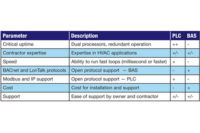The basic concepts of energy efficient lighting control are fairly straightforward: deliver the required amount of light for safety and productivity. To do this, there are two fundamental strategies:The expectations for improved energy efficiency and the requirements in the new energy codes are driving a need for improved lighting control. On many projects, lighting control has not had the same focus as HVAC control, due to challenges with budgets, division of design labor, and convention. But all of that is starting to change and we should be looking toward lighting control as a part of future new construction and retrofit projects.
• Occupancy-based control. Bring lights on when areas are occupied and turn them off when they are not occupied. This can be achieved using time-based scheduling, or with the use of occupancy or vacancy sensors that turn lights on or off based on motion.
• Daylight harvesting. Increase or decrease lighting levels when natural light is present.
Traditionally, lighting control solutions have been provided as part of the BAS or from a specialized lighting control system. These solutions have continuously improved, providing for options for open systems integration, modular installation, and new tools for reducing the cost of installation and programming.
So what does the future hold for lighting control? We are starting to see a number of new solutions coming on the market that are designed around integrated lighting control for LED or solid-state lighting. Here are a few examples:
• Digital lumens. Integrated solution primarily for high bay industrial applications that offers an LED fixture with integrated controls for occupancy sensing and daylight harvesting. Fixtures can communicate wirelessly for monitoring, programming, and coordination.
• Redwood systems. Providing a DC wiring infrastructure for solid-state lighting that includes both power and controls in a single cable bundle.
• Greenchip from NXP. A new technology that can be built into solid-state and CFL lamps to give each one an IP address and wireless communications. Moving control and communications into long life bulbs could be a “game changer” in allowing for integrated lighting control.
Moving to solid-state lighting offers many other benefits in addition to improved control. These include reduced energy usage and less heat, as well as long bulb life. There is a lot of work going on to bring the cost of this technology down, and it is anticipated to become dominant within the next 10 yrs. As this transition occurs, control will come along as part of it and as system designers, we need to be ready for this change. ES





